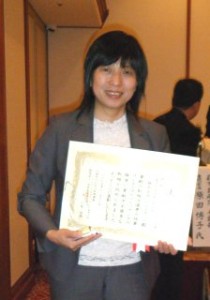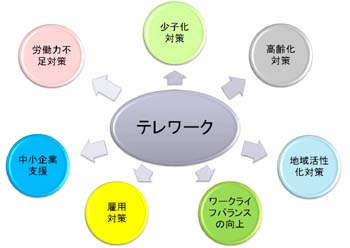WIT Life #57: Teleworking in Japan
WITLife is a periodic series written by professional Translator/Interpreter/Writer Stacy Smith (Kumamoto-ken, 2000-03). Recently she’s been watching Fujisankei’s newscast in Japanese and sharing some of the interesting tidbits and trends together with her own observations.
My only time traveling one-on-one as an interpreter for the Department of State’s International Visitor Leadership Program was a year ago with a female entrepreneur from Hokkaido named Yuri Tazawa. No one epitomizes the “Yes We Can” spirit more than Yuri, so it was appropriate that we were able to celebrate Obama’s victory together while in DC. She began a company in a town called Kitami 11 years ago after being raised in Nara, going to university in Tokyo, and starting a family. You might wonder what kind of business one could have being located so far away from a metropolis, but Yuri heads a company called Y’s Staff (taking the Y from her name as well as being a homonym with “wise”).
Y’s has offices in both Hokkaido and Nara, but its actual structure is virtual. Through her company, Yuri is a promoter of teleworking. This concept is often confused with telemarketing, but is essentially the idea of doing work in a place other than a fixed office. This could be your home, the local Starbucks or any other location. Yuri also advocates employing the underutilized Japanese female work force, many of whom are not active due to having to relocate for their husbands’ jobs or having to take care of older family members/kids. Teleworking provides a flexible arrangement that would allow them to work for as long or short as they want regardless of where they are.
Employees in Yuri’s company are scattered all over the country as well as abroad. Yuri’s background is in IT, and Y’s takes projects ranging from translation/editing to web page creation. When she receives a request, she shares this information with all her employees via the company network. Those that are interested in collaborating on that particular project respond, and a team is thereby created. Next the work is divided so that the assignment can be efficiently carried out. To use a translation project as an example, it could potentially be shared among translators living in Okinawa, Kumamoto, Tokyo and Canada who use tools such as email (Yuri has created the patented unique mail system that they use) and Skype to communicate. As long as team members can constantly be in touch, it is not their locations that matter but the actual work that is done.
The other day Yuri proudly informed me that her company had received an “incentive award” or “encouragement prize” from the Work Life Balance Promotion Committee. Although work life balance is not the first thing most people associate with Japan, this group is trying to change this. The above picture shows Yuri receiving her award from the committee, and I think it is amazing for a small company in Hokkaido to receive this well-deserved recognition. Yuri also recently contributed an article to Nikkei Net regarding teleworking, and it brings up some interesting points.
In her piece, she highlights the fact that teleworking is a useful  solution to the country’s current economic woes. In this image on the left, the center oval represents telework and the outlying ovals depict the various measures it can help implement. Starting with the top green one and going clockwise the ovals read: reduced birth rate, aging of the population, community revitalization, improvement of work-life balance, employment, small business support and labor shortage. Following this diagram Yuri goes on to explain in detail how teleworking can be a source of improvement in each of these areas.
solution to the country’s current economic woes. In this image on the left, the center oval represents telework and the outlying ovals depict the various measures it can help implement. Starting with the top green one and going clockwise the ovals read: reduced birth rate, aging of the population, community revitalization, improvement of work-life balance, employment, small business support and labor shortage. Following this diagram Yuri goes on to explain in detail how teleworking can be a source of improvement in each of these areas.
For example, population decline due to a decreasing birth rate is plaguing Japan, but if both women and men knew that flexible work styles were an option they might be more willing to consider having a family. Women are conflicted about having children as it often means pausing or even concluding their careers, and men are unable to take time off to help raise their children. Incorporating ideas such as flextime, shorter hours and allowing workers to do their jobs in places other than the office would go a long way in making people feel less anxious about how their personal choices will affect their employment situations.
The article also discusses the Action Plan to Double the Teleworking Population proposed two and a half years ago by four of Japan’s governmental ministries, and its goal is to have 20% of the working population teleworking by 2010. As of 2008 this number stood at 15%, so this is a realistic target. However, Yuri acknowledge that having companies that are receptive to this way of working is a key factor that will make or break achievement of this goal. Currently it is only major companies such as automakers and financial firms that support teleworking, causing people to think that they have to live in large cities where these companies are located in order to take advantage of this working style. This completely defeats the purpose of the concept.
Although Yuri often travels to Tokyo and other areas of Japan on business, without teleworking she would not be able to be based in a place as remote as Hokkaido. As she would often say to me, “I created my company to be able to live somewhere with as much natural beauty as Kitami.” She opted for this environment to raise her three daughters, and thanks to telework she doesn’t feel like she should have to choose between quality of life and employment.
To learn more about Japan’s teleworking situation and Yuri’s promotion efforts, check out her (Japanese) blog at: http://telework.blog123.jp/!


Comments are closed.